#pratityasamutpada
Text
“All know that the drop merges into the ocean, but few know that the ocean merges into the drop.”
— Kabir
85 notes
·
View notes
Photo
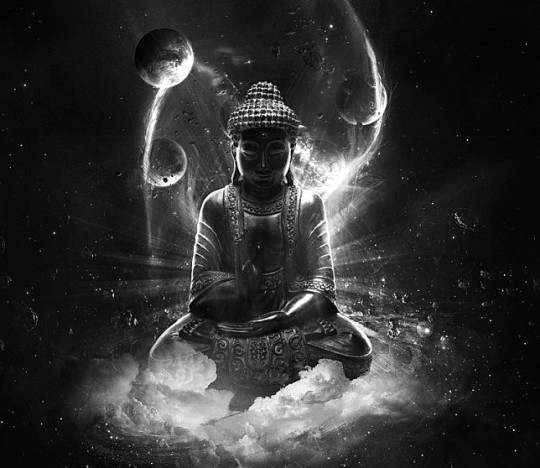
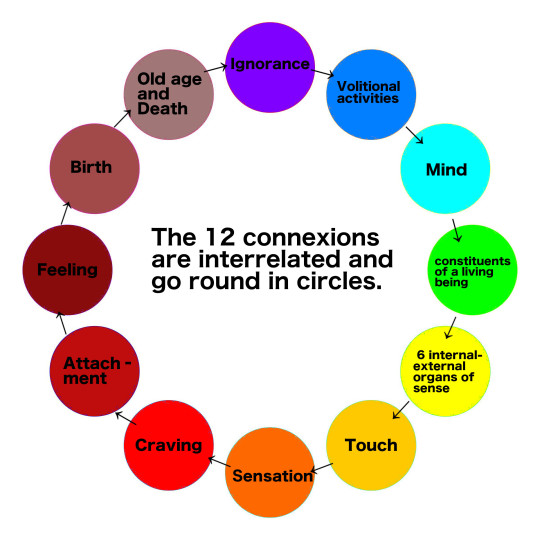
The Quest for Buddhism (58)
Pratityasamutpada – the 12 links of conditioned arising - Part 3
From 7 to 12 causal branches continued as follows [See: 1 -6]:
7. Sensation – vedana is a Buddhist term referring to the sensing action of humans. It is the feeling of touch. The six senses come into contact with the six external sense organs through the six internal sense organs and sense them. Besides physical and physiological sensations such as 'hot' and 'painful', including those that are perceptually felt by the mind, such as suffering and pleasure. For example, feeling 'beautiful' when looking at nature.
8. Craving – trsna (tanha) is an important concept in Buddhism, referring to "thirst, desire, longing, greed", either physical or mental. The sanskrit word “trsna” is typically translated as craving, and is of three types: "craving for sensual pleasures", "craving for existence", and "craving for non-existence".Trsna is also mentioned in the 4 Sacred Truths, which state that it is the cause of suffering and that this causes living beings to repeat death and rebirth in the wheel of samsara.
9. Attachment– upadana means "fuel, material cause, substrate that is the source and means for keeping an active process energised". It is also an important Buddhist concept referring to "attachment, clinging, grasping". It is considered to be the result of trsna (craving), and is part of the dukkha (suffering, pain) dogma in Buddhism.
10. Feeling – bhava is the state of existence of a living being, the area of survival. It refers to the state in which sentient beings go through ‘trailokya’ in the cycle of samsara (reincarnation). Trailokya stands for the three realms that are the world of greed, the world of pure matter, free from desire(colour), and the world that transcends both desire and material conditions and dwells only in mental action (colourlessness).
11. Birth – Jati refers to the repeated existence of a person as a new life through samsara (reincarnation).
12. Old age and Death – Jaramarana stands for "old age" (jara) and "death" (marana). In Buddhism, jaramarana is associated with the inevitable decay and death-related suffering of all beings prior to their rebirth within samsara (cyclic existence).
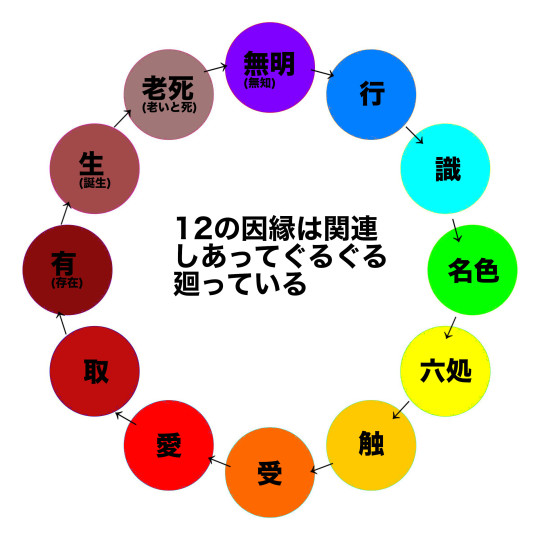
仏教の探求 (58)
十二因縁 (じゅうにいんねん、梵: プラティチャサムトパーダ)・その3
七〜十二の支分は以下の通りに続く(参照: 1〜6):
7. 受 (じゅ、巴・梵: ヴェーダナー)とは、人間の感受作用を意味する仏教用語。触れたことを感じることである。六識が六根を通じ六境に接触し、まずそれを感受すること。肉体的、生理的に感じる「暑い」「痛い」などの感じの他にも、「苦しい」「快い」などの、心で知覚的に感じるものも含んでいる。例えば、自然を見て「美しい」と感じること。
8. 渇愛 (かつあい、梵: トリシュナー、巴: ターナー)は仏教における重要な概念で、肉体的または精神的な「渇き、欲望、あこがれ、貪欲」を意味する。サンスクリット語の「トリシュナー」は、通常、渇愛と訳され、「官能的快楽への渇愛」、「存在への渇愛」、「非存在への渇愛」の3種類がある。さらに渇愛は四諦 (したい、梵: チャトゥル・アーリヤ・サティヤ、4つの聖なる真理の意)にも記されており、それは苦の原因であり、これによって生けるものは輪廻の輪において死と再生を繰り返すとしている。
9. 取 (しゅ、梵・巴: ウパーダーナ)とは「燃料、物質的な原因、活動的なプロセスを活気づける源や手段である基質」を意味する。 また「執着、しがみつき、把握」を指す重要な仏教概念であり、トリシュナー (渇愛)の結果と考えられ、仏教のダッカ(苦痛) の教義の一部となっている。
10. 有 (う、梵: バーバ)とは、とは、生きものの生存状態、生存領域。三界を衆生が輪廻していく状態を指す。三界とは「欲望の世界(欲界)」「欲望を離れた清浄な物質の世界(色界)」そして「欲望も物質的条件も超越し、ただ精神作用にのみ住む世界(無色界)」の三つの世界のこと。
11. 生(しょう、梵:ジャーティ)とは、サンサーラによって新しい生命として、繰り返し存在しつづけることを指す (輪廻転生)。
12. 老死 (ろうし、梵:ジャラマラナ)とは、ジャラマラナとは「老い(ジャラ)」と「死(マラナ)」のこと。すべての生き物がサンサーラ(循環する存在)の中で生まれ変わる前に避けられない衰えと死に関連する苦しみのこと。
#pratityasamutpada#dvadasangika-pratityasamutpada#buddhism#buddha#reincarnation#samsara#the 12 nidānas#12 causal branches#nirvana#philosophy#nature#art#karma
149 notes
·
View notes
Text
“In his [recorded sayings], Huangbo Xiyun unequivocally states: “Speaking is silence; silence is speaking; speaking and silence are nondualistic.”
Another Chan master, Dazhu Huihai, construes Vimalakirti’s silence as being beyond speaking and non-speaking, a silence of the duality between silence and speech – a strategy very similar to Madhyamaka’s emptiness of emptiness and Zhuangzi’s nothingness of nothingness.
In saying this, Chan masters demonstrate that they apply the principle of pratityasamutpada (interdependent arising) to the issue of speech and silence, presenting a non-isolated, truly relational understanding of speech and silence. Speech and silence thus no longer have their self-identity. One always functions in relation to the other, and each always has its absent presence in the other. Each always retains traces of the other.
Sengzhao’s saying, “Speech always has something unspoken,” might be a good footnote to the Chan notion of the speech-silence relation. Chan masters might add one more point to Sengzhao’s saying: silence always speaks.”
Youru Wang, “Liberating oneself from the absolutized boundary of language”, Philosophy East & West V. 51, pp. 83-99
36 notes
·
View notes
Text

When Lord Buddha said that the Sad-dharma he taught is eternal, it seems that he had two ideas: a) The ultimate truth of a living world (i.e.
Pratityasamutpada) is always continuous from eternity, while the laws of mind are eternally universal. (Just as malice does not die by malice towards others, only friendship dies). b) In various suttas, it has been mentioned that the teaching he taught was the same teaching taught by previous Buddhas and that such Buddhas are extremely numerous.
We know from various sources that when he was a bodhisattva, he met and learned from millions of old Buddhas like Dipankara. In Mahayana Buddha Samantabhadra is presented as the concept of Adi Buddha. Since the world has no beginning and no end, it is a symbolic concept that also refers to the mind nature of each sattva, while also implying the infinite series of Buddhas. Therefore, there is no justification in Buddhism for questions such as what religion did Buddha's father practice, Buddhism existed only for 2500 years, and what was before that. Also, Buddhist scriptures are authentic sources. Buddhism is clear on these questions. They were not Vedic-Hindu and almost all Shakyas died as Buddhists.
2 notes
·
View notes
Text
“En Fundamentos de la vía media, una de las obras más influyentes en la historia de la filosofía india, Nagarjuna expone su concepción del vacío (sunyata). La vacuidad es para Nagarjuna, paradójicamente, la esencia del mundo, pero se trata de una esencia muy particular, una esencia vacía. El término es equivalente a otro concepto de gran prestigio entre los escolásticos budistas, pratityasamutpada, que hace referencia a la condicionalidad de todas las cosas, a su esencial contingencia. Las cosas depende unas de otras. Tanto los seres que habita el cosmos (animales, plantas, fantasmas, seres mitológicos y humanos) como las diferentes entidades que lo amueblan (planetas, minerales, paraísos, infiernos, ideas, esperanzas y sufrimientos) comparte una característica en común: carecen de naturaleza propia y son, por tanto, vacíos. Esta circunstancias hace que, para existir, las cosas se apoyen unas en otras, dependan unas de otras. De modo que aunque el lenguaje convencional (ya sea el habla común o el lenguaje religioso o científico) se refiera a ‘seres’ y ‘cosas’, éstas no son sino la ilusión creada por el pensamiento conceptual, que deriva de nuestra necesidad de expresarnos y comunicarnos pero carece de realidad al margen de esas necesidades. Y, sin embargo, gracias a esa ilusión podemos entendernos, y gracias a ella la enseñanza de Buda puede ser transmitida y producir la transformación interior a la que va destinada. Esta ambivalencia de la vacuidad, ese hacer posible el decir y, al mismo tiempo, no decir nada, llevó a los filósofos a relacionarla con el silencio del sabio”.
Antropología del budismo, Juan Arnau
7 notes
·
View notes
Text
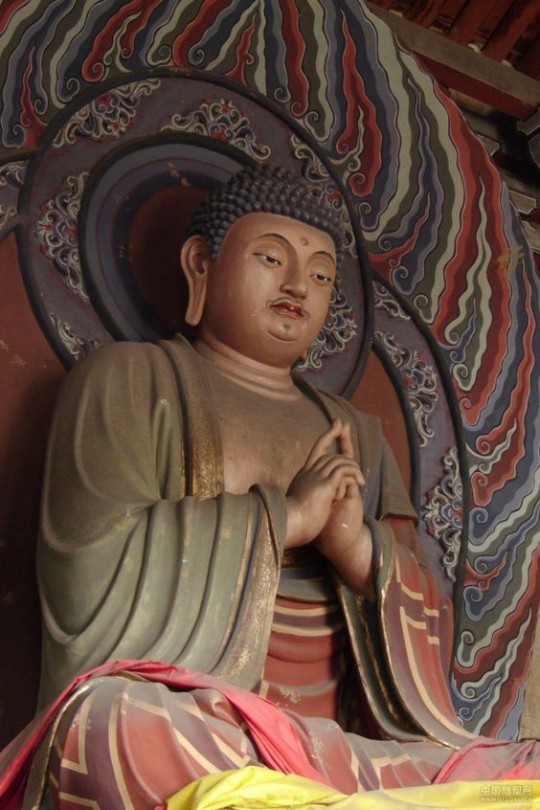
Sakaymuni Buddha once said, if one fully understood these 12 links of Dependent Origination (Pratityasamutpada), he or she will attain Nirvana and be free from the cycle of existence (Wheel of Life)
釋迦牟尼佛曾說,若人完全理解此十二緣起支,他(她)將証悟涅槃,從輪迴中解脫
0 notes
Text

T7. 17. 09. 2022.
Ngày hai mươi hai tháng tám năm Nhâm Dần.
THẤY ĐƯỢC TÁNH DUYÊN KHỞI LÀ THẤY ĐƯỢC PHÁP TÁNH
Trong kinh Pratityasamutpada, đức Phật nói rằng thấy tánh duyên khởi là thấy Pháp, thấy Như Lai, thấy Phật. Câu này có nghĩa là thấy được tánh duyên khởi là thấy được Pháp tánh ở nhiều mức độ khác nhau. Ví dụ, hiểu lý duyên khởi trong nhân quả là hiểu Pháp tánh qua luật nhân quả, nhờ đó có thể xây dựng nền tảng cho đời sống giới hạnh thanh tịnh, và chánh kiến về nhân quả được xem là một mức độ chánh kiến về Pháp.
~ Đức Dalai Lama 14
Tôn ảnh: Đức Phật Mẫu Tôn Thắng.
Phuoc Linh Temple - BRVT.
0 notes
Photo
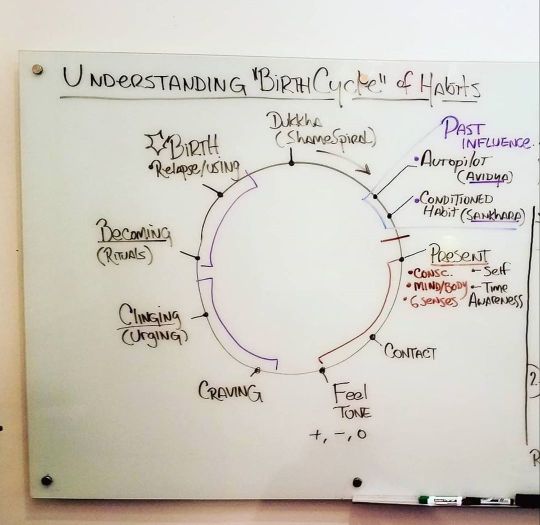
The First Step of Transformation The Buddha saw: our thoughts, emotions, and actions are the primary sources of our suffering. Equally, our thoughts, emotions, and actions can be the source of our joy and freedom. Living, as much as possible, with conscious intention is the first step of this transformation. —Thupten Jinpa, “Two Exercises for Turning Intention into Motivation” #Pratityasamutpada (at New Haven Zen Center) https://www.instagram.com/p/B60rycXgCXU/?igshid=f7tew7y1n13s
1 note
·
View note
Photo
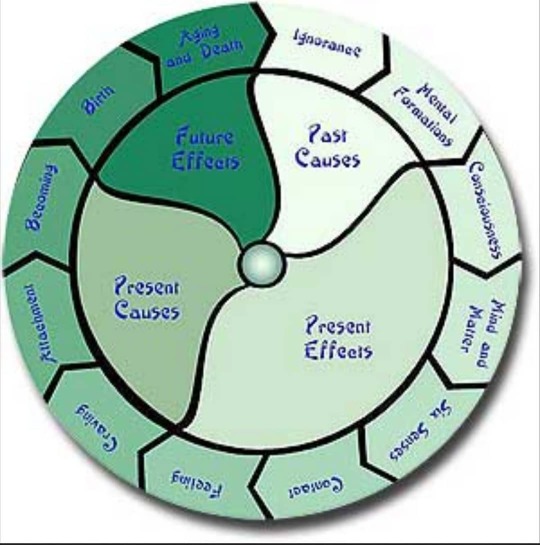
The First Step of Transformation The Buddha saw: our thoughts, emotions, and actions are the primary sources of our suffering. Equally, our thoughts, emotions, and actions can be the source of our joy and freedom. Living, as much as possible, with conscious intention is the first step of this transformation. —Thupten Jinpa, “Two Exercises for Turning Intention into Motivation” #Pratityasamutpada (at Burlington, Connecticut) https://www.instagram.com/p/B60rcdfp3au/?igshid=1k999fuag54pg
0 notes
Text
“All know that the drop merges into the ocean, but few know that the ocean merges into the drop.”
— Kabir
49 notes
·
View notes
Photo

The Quest for Buddhism (76)
Four Noble Truths - The first Dhamma wheel turned・Part2 (1. Duhkha)
2) Samudaya
Samudaya satya is the 2nd of the Four Noble Truths (Ref) , and it is the concept that the cause of suffering is the love attachment.
It is the truth that the endlessness of desire gives rise to suffering, that is, the truth that 'suffering has a cause'. The truth of the arising of suffering. It refers to the source of suffering, the Kleshas (worldly desires) that cause the manifestation of suffering, and is therefore also called "duhkha samadhya satya" The word 'samudaya' means 'to invite and collect', and it is said that the things that invite and collect suffering are the worldly desires.
Specifically, it refers to the mind's defilements such as greed, anger and complaining, and its root, craving (Skt. trishna). These are the impulsive emotions that lead to the unceasing pursuit of desires.
In Buddhism, the 12 links of conditioned arising (Skt. Pratityasamutpada Ref2) show and represent the structure of the causes of suffering. It shows the twelve causes of suffering and their edges. Suffering is a system of the 12 causes (Ref3 &Ref4), and when the 12 are gathered together, the whole of it is suffering. Therefore, both avidya and craving are the root causes of suffering, and are the "duhkha samadhya satya" (suffering and collection).
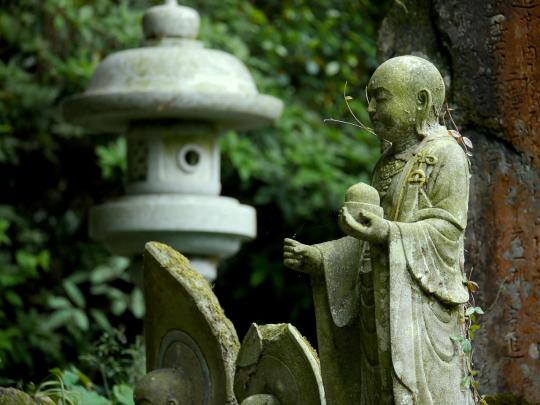
仏教の探求 (76)
四諦 (したい、梵: チャトゥル・アーリヤ・サティヤ) 〜 最初に回されたダンマの輪・その2(①苦諦)
②集諦 (じったい)
集諦 (じったい、梵: サムダヤ・サティヤ)とは、四諦 (したい、梵: チャトゥル・アーリヤ・サティヤ 参照)の第二であり、苦の原因は愛執の念であるという概念である。
それは、欲望の尽きないことが苦を生起させているという真理、つまり「苦には原因がある」という真理。苦しみの生起の真理。苦しみの源、苦しみを現出させる煩悩(梵:クレーシャ)を指すので、苦集諦 (くじゅうたい、梵: ドゥッカ・サムダヤ・サティヤ)ともいわれる。集 (じゅう、梵: サムダヤ)とは「招き集める」という意味で、苦を招き集めるものは煩悩であるとされる。
具体的には貪欲や瞋恚(しんに)、愚痴などの心のけがれをいい、その根本である渇愛(かつあい, トリシュナー)をいう。これらは、欲望を求めてやまない衝動的感情をいう。
仏教において苦の原因の構造を示して表しているのは、十二縁起(参照2)である。十二縁起とは、苦しみの12の原因(参照3&参照4))とその縁を示している。苦は12の原因のシステムであって、12個集まってそれ全体が苦なのである。だから、無明(むみょう)も渇愛(かつあい)も、苦しみの根本原因であり、苦集諦(くじゅうたい)である。
#samudaya#satya#four noble truths#pratityasamutpada#12 causal branches#trishna#craving#avidya#suffering#origin of suffering#buddhism#nature#philosophy#art
89 notes
·
View notes
Video
youtube
Are you ready for some Deep Sam Flam lore?
...Well, kind of?
I have started a project to compile as many Samurai Flamenco quotes as possible and put them in a Twitter text bot. This is partially for my own amusement, but also so I can collect Samurai Flamenco translations and put it in the attached linktree for cohesiveness. I am starting with quotes from the anime, which includes song lyrics.
...So, I came to a bit of a conundrum when I got to episode 4, Idol Devastation, and Mari blasted a song out of her hummer. Turns out that it is not an original song, but I made an Executive Decision to put it in the bot regardless. Except there’s no English translation. And Japanese lyric websites don’t have it properly transcribed. And it turns out that it requires hours and hours of research to properly decipher all of its religious references.
If you would like to just know the lyrics to the song, they are as follows:
Tera Zukkyun! Ai no Ryouhouji!
Before our love ripens, we’ll have an eternal sleep! Ryoyhou Temple!
Anye manye mane mamane cite carite shame
Shamitavi shamte mukte
It’s a miracle! Ryouhou Temple!
The shintai will help you, shining halo guidepost
Leave the prayers to me; the mutual love of one hundred shrine visits
Lotus Sutra, Chishaku, bodhisattva Manjushri, bhava!
This sutra is profound, complex, subtle, and treasured; worship!
You’re troubled, aren’t you? (Mt. Fuji kamikaze)
You’re in agony, aren’t you, aren’t you? (Shuriken tempura)
Right now, come come come take shelter (Unruly bonze)
Brain fragmentation
Temple buh-bam! Temple buh-bam!
The Ryouhou Temple of love love love love love!
Singing and studying and dancing love will fulfill you
The love love love love love of Hachiouji!
Your hypermutation! Ecstasy! Embrace sukhavati!
Syrupy Tro-Benten!
Sold lots tower over the cemetery’s shining headstone
We’ll give a warm welcome to even the most inexperienced
Bhava, bhava, sattva, sadhana, devote yourself to this sutra to attain bodhi!
Manjushri said the daughter of the dragon king Sagara did this year!
You’re anxious, aren’t you? (Pervert tsundere)
You’re forlorn, aren’t you aren’t you? (Tiny boobs, fatty cut sushi)
Right now, come come come take shelter (Nipples, decapitation)
Entering nirvana, reincarnation
Temple buh-bam! Temple buh-bam!
The Ryouhou Temple of love love love love love!
With my sparkling sadhana, attaining enlightenment, I’ll come into moksha!
The love love love love love of Hachiouji!
Your hypermutation! Ecstasy! Embrace sukhavati!
Syrupy Tro-Benten!
Eight years! (Eight years!) Eight years! (Eight years!) Eight years! (Eight years!) Innate prajna! (Love!)
Factor of life: form, factor of life: nature, factor of life: embodiment, factor of life: potency
Eight years! (Eight years!) Eight years! (Eight years!) Eight years! (Eight years!) Innate prajna! (Love!)
Factor of life: function, factor of life: primary cause, factor of life: secondary cause, factor of life: effect
Eight years! (Eight years!) Eight years! (Eight years!) Eight years! (Eight years!) Innate prajna! (Love!)
Factor of life: recompense, factor of life: recompense, factor of life: recompense, factor of life: recompense
Factor of recompense, factor of recompense, factor of complete fundamental whole
The Ryouhou Temple of love love love love love!
Singing and studying and dancing love will fulfill you
The love love love love love of Hachiouji!
Your hypermutation! Ecstasy! Embrace sukhavati!
Syrupy Tro-Benten!
Temple buh-bam! Temple buh-bam!
You’ll fall in love! Ryouhou Temple!
However, if you want a big deep dive on the lyrics, here it is:
This is the theme song for Ryouhou Temple, a Buddhist temple in western Tokyo. The temple is notable for being...moe, to the degree that it’s nicknamed moeji (moe temple). The reason for this is that it features a moe-fied version of Benzaiten. Benzaiten is a Buddhist goddess, often shown with a biwa.
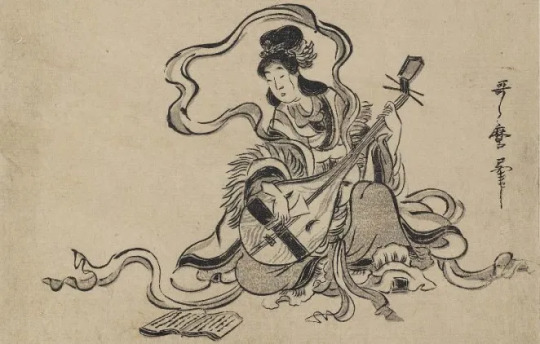
She is the Japanese version of Saraswati, the Hindu goddess of music and wisdom.

The moe version of which is Tro-Benten.

This video is a pretty good summary of the surreal nature of Ryouhouji. With that out of the way, here’s a breakdown.
恋の実ったその先は二人で永眠!了法寺ー!
Koi no minotta sono saki wa futari de eimin! Ryouhouji!
Before our love ripens, we’ll have an eternal sleep! Ryouhou Temple!
“Eternal sleep” or “eimin” here is actually a phrase in Christianity, especially the Orthodox Church. It is a euphemism for death in the Bible.
安爾 曼爾 摩禰 摩摩禰 旨隷 遮梨第 貝余
Ani mani mane mamane shire sharite shamya
Anye manye mane mamane cite carite shame
This is sanskrit, and each of these words is a spell. Technically, each kanji character has meaning, but they serve more of a phonetic sense than a semantic one. Here is the meaning of each of these spells (per this link)
Anye: mysterious
Manye: pondering
Mane: mindfulness
Mamane: serenity in mind
Cite: eternity
Carite: religious practice
Shame: tranquility
貝余履 多王韋 羶帝 目帝
Shabi tai sentei mokutei
Shamitavi shamte mukte
Shamitavi: non-attachment
Shamte: inexpressibly serene silence
Mukte: emancipation
ご利益あります!了法寺!
Goryaku arimasu! Ryouhouji!
It’s a miracle! Ryouhou Temple!
お助けします御神体輝く後光の道しるべ
Otasuke shimasu goshintai kagayaku gokou no michishirube
The shintai will help you, shining halo guidepost
A shintai is a physical object worshipped at temples that has a spirit in it.
They can have a lot of different forms; here is an example:

However, this is the shintai at Ryouhouji:

恋の願いはお任せ��お百度参りで両思い
Koi no negai wa omakase yo ohyaku domairi de ryouomoi
Leave the prayers to me; the mutual love of one hundred shrine visits
Hyakudomairi, or one hundred shrine visits, is a practice in Shinto. It’s what it sounds like - visiting a shrine to pray one hundred times.
妙 法華経 智積 菩薩 問文殊 師利言 有!
Myou hougekyou chishaku bosatsu monmonju shirigon u!
Lotus Sutra, Chishaku, bodhisattva Manjushri, bhava!
In general, sutras are canonical scriptures within Buddhism. Buddhism has two main branches - Mahayana and Theravada. Mahayana Buddhism is popular in East Asia, and the Lotus Sutra is one of the most influential texts within that branch. More specifically, it is used for the Nichiren and Tendai sects of Buddhism. Here is a link with a basic breakdown of the concept.
Chishaku(-in) is a Buddhist temple in Kyoto. It is the headquarters of Chisan-ha sect of Shingon Buddhism. That is a sub-section of Vajrayana Buddhism, spread from India to East Asia. In turn, Vajrayana is part of Mahayana Buddhism.
The person for whom the temple was named, Chishaku, is also known as Wisdom Accumulated. He is the oldest son of Great Universal Wisdom Excellence Buddha.
A bodhisattva is someone who is on the path to Buddhahood.
Manjushri is a bodhisattva associated with prajna (wisdom) in Mahayana Buddhism.
Bhava is a term meaning earthly tendencies, birth, and production. Bhava is one of the twelve links of Pratityasamutpada, originally taught by Great Universal Wisdom Excellence. Pratityasamutpada is a key doctrine within Buddhism which emphasizes the connectiveness of all phenomena (dharma).
此経 甚 深 微妙 諸経 中 宝 世所 希有 拝!
Shigyou jinjin mimyou shochou chuu hou sesho keu hai!
This sutra is profound, complex, subtle, and treasured; worship!
This is a reference to Chapter 12 of the Lotus Sutra, in which Chishaku asks Manjushri if one can quickly obtain Buddhahood through practicing the Lotus Sutra.
悩んでいるのでしょう(フジヤマ カミカゼ)
Nayande iru no deshou (fujiyama kamikaze)
You’re troubled, aren’t you? (Mt. Fuji kamikaze)
English-speakers probably know kamikaze in terms of World War II. However, it is also a reference to a typhoon thought to protect Japan from a Mongolian invasion in the 13th century.
...As a side note, the bits in parentheses are sung in an American accent. Make of that what you will.
悶えているのでしょでしょ(シュリケン テンプラ)
Modaete iru no desho desho (shuriken tenpura)
You’re in agony, aren’t you, aren’t you? (Shuriken tempura)
Shuriken is a fairly well-known term, but it is a star-shaped concealed weapon.

Tempura is a popular Japanese dish of meat or vegetables fried in batter (would recommend).

今すぐ来て来て来て駆け込んで(ボウズ ノホウズ)
Ima sugu kite kite kite kakekonde (bouzu nohouzu)
Right now, come come come take shelter (Unruly bonze)
A bonze is a Japanese or Chinese Buddhist monk. In common speech, you’ll often hear “bouzu” as a casual way to refer to boys. This is a reference to the word “bonze.”
脳みそフラグメンテーション
noumiso furagumenteeshon
Brain fragmentation
テラズッキュン寺ズッキュン
Tera zukkyun tera zukkyun
Temple buh-bam! Temple buh-bam!
Tera means temple. The first tera in this is in katakana, and the second is in kanji. I translated them the same, but the first tera may mean the prefix tera-. Terabyte is an example; you could see this line as a SUPER zukkyun.
Zukkyun is a sound effect for gun shots, like “pew pew,” “bang bang,” etc. However, it also is used as a sound effect for rapidly falling in love with something. You can think about it similarly to how one is shot with Cupid’s arrow. Zukkyun can be a sound effect for actual romantic love, or just casual internet talk for indicating you really like something.
愛の愛の愛の愛の愛の了法寺!
Ai no ai no ai no ai no ai no ryouhouji!
The Ryouhou Temple of love love love love love!
歌って学んで踊って恋が成就します
Uttate manande odotte koi ga jouju shimasu
Singing and studying and dancing love will fulfill you
愛の愛の愛の愛の八王子!
Ai no ai no ai no ai no hachiouji!
The love love love love love of Hachiouji!
Hachiouji is where Ryouhouji is located, in West Tokyo.
you超変!有頂天!朴楽抱きしめてね
You chouhen! Uchouten! Gokuraku dakishimete ne
Your hypermutation! Ecstasy! Embrace sukhavati!
This is a reference to Pure Land Buddhism, or Amidism, which is a branch of Mahayana Buddhism. Amitabha is the principal Buddha of this, and the basic idea is that the world is corrupt, so people should wish to be reborn in the Pure Land instead. Sukhavati is the western part of the Pure Land.
とろとろとろ弁天!
Torotoro torobenten!
Syrupy Tro-Benten!
分譲しますぼっち墓地輝く墓石そびえ立つ
Bunjou shimasu bocchi bochi kagayaku boseki sobietatsu
Sold lots tower over the cemetery’s shining headstone
未経験者も大歓迎お一人様でもお気軽に
Mikeikensha mo daikangei ohitorisama demo okigaru ni
We’ll give a warm welcome to even the most inexperienced
頗有頗有衆生 勤加精進 修行 此経 速得仏不
Hau hau shuujou gonka shoujin shugyou shigyou sokutoku bubbu
Bhava, bhava, sattva, sadhana, devote yourself to this sutra to attain bodhi!
In Samkhya, one of the six schools of Hindu philosophy, sattva is one of three gunas. Gunas are the modes of existence (traits) that one may have, and sattva means the quality of balance. It is connected with purity, and serenity.
Sadhana is essentially a disciplined ritual used to obtain one’s goals. The classic trope of standing under a waterfall is an example of Japanese Buddhist sadhana.
Bodhi essentially means “awakening,” often in reference to enlightenment.
文殊 師利 言言有有 裟 竭 羅龍王 女 年始
Monju shiri gongon uu shakatsura ryuu ounyo nenshi
Manjushri said the daughter of the dragon king Sagara did this year!
This is another reference to Chapter 12 of the Lotus Sutra. When Wisdom Accumulated/Chishaku asks if someone can attain Buddhahood through studying the Lotus Sutra, Manjushri mentions that the dragon princess already has.
不安があるのでしょう(ヘンタイ ツンデレ)
Fuan ga aru no deshou (hentai tsundere)
You’re anxious, aren’t you? (Pervert tsundere)
Anime fans probably know this, but tsundere is a portmanteau of tsun tsun, and dere dere. Tsun tsun is basically standoffishness, and dere dere is having a sweet demeanor. A tsundere is a character/person that blends these traits in some way. They are usually either sweet, but become irritable, or irritable by default, then become sweet under some circumstances.

(Hidenori “It’s Not Like I’ll Marry You Or Anything B-baka!” Goto is a tsundere.)
心細いのでしょでしょ(ヒンニュウ スシトロ)
Kokorobosoi no desho desho (hinnyuu sushitoro)
You’re forlorn, aren’t you aren’t you? (Tiny boobs, fatty cut sushi)
今すぐ来て来て来て駆け込んで(チクビ ウチクビ)
Ima sugu kite kite kite kakekonde (chikubi uchikubi)
Right now, come come come take shelter (Nipples, decapitation)
成仏リインカーネーション
Joubutsu riinkaaneeshon
Entering nirvana, reincarnation
Nirvana is a concept in Buddhism (and other Indian religions) that means the release from reincarnation. It is the ultimate goal for salvation.
テラズッキュン寺ズッキュン
Tera zukkyun tera zukkyun
Temple buh-bam! Temple buh-bam!
愛の愛の愛の愛の愛の了法寺!
Ai no ai no ai no ai no ai no ryouhouji!
The Ryouhou Temple of love love love love love!
修行でピカって悟って解脱しちゃいます
Shugyou de pikatte satotte gedatsu shichaimasu
With my sparkling sadhana, attaining enlightenment, I’ll come into moksha!
Moksha is the release from reincarnation. The difference between this and nirvana vary by religion and branch.
愛の愛の愛の愛の八王子!
Ai no ai no ai no ai no hachiouji!
The love love love love love of Hachiouji!
you超変!有頂天!極楽抱きしめてね
You chouhen! Uchouten! Gokuraku dakishimete ne
Your hypermutation! Ecstasy! Embrace sukhavati!
とろとろとろ弁天!
Torotoro torobenten!
Syrupy Tro-Benten!
八歳!(八歳!) 八歳!(八歳!) 八歳!(八歳!) 智慧利根!(愛!)
Hassai! (Hassai!) Hassai! (Hassai!) Hassai! (Hassai!) Chie rikon! (Ai!)
Eight years! (Eight years!) Eight years! (Eight years!) Eight years! (Eight years!) Innate prajna! (Love!)
“Eight years” is a reference to the fact that Sagara’s daughter was only eight when she attained Buddhahood.
如如是相 如如是性 如如是体 如如是力
Nyonyozesou nyonyozeshou nyonyozetai nyonyozerisa
Factor of life: form, factor of life: nature, factor of life: embodiment, factor of life: potency
This is a reference to the Buddhism Ten Factors of Life. Interestingly, these factors were not originally in the Sanskrit text. They were added by the translator, Kumaraju, in the 5th century.
八歳!(八歳!) 八歳!(八歳!) 八歳!(八歳!) 智慧利根!(愛!)
Hassai! (Hassai!) Hassai! (Hassai!) Hassai! (Hassai!) Chie rikon! (Ai!)
Eight years! (Eight years!) Eight years! (Eight years!) Eight years! (Eight years!) Innate prajna! (Love!)
如如是作 如如是因 如如是縁 如如是果
nyonyozesa nyonyozein nyonyozeen nyonyozeka
Factor of life: function, factor of life: primary cause, factor of life: secondary cause, factor of life: effect
八歳!(八歳!) 八歳!(八歳!) 八歳!(八歳!) 智慧利根!(愛!)
Hassai! (Hassai!) Hassai! (Hassai!) Hassai! (Hassai!) Chie rikon! (Ai!)
Eight years! (Eight years!) Eight years! (Eight years!) Eight years! (Eight years!) Innate prajna! (Love!)
如如是報 如如是報 如如是報 如如是報
nyonyozehou nyonyozehou nyonyozehou nyonyozehou
Factor of life: recompense, factor of life: recompense, factor of life: recompense, factor of life: recompense
八歳!(八歳!) 八歳!(八歳!) 八歳!(八歳!) 智慧利根!(愛!)
Hassai! (Hassai!) Hassai! (Hassai!) Hassai! (Hassai!) Chie rikon! (Ai!)
Eight years! (Eight years!) Eight years! (Eight years!) Eight years! (Eight years!) Innate prajna! (Love!)
如如報如 如あ如報 如如是本末究竟等
nyonyohounyo nyoanyohou nyonyoze honmatsukukyoutou
Factor of recompense, factor of recompense, factor of complete fundamental whole
愛の愛の愛の愛の愛の了法寺!
Ai no ai no ai no ai no ai no ryouhouji!
The Ryouhou Temple of love love love love love!
歌って学んで踊って恋が成就します
Utatte manande odotte koi ga jouju shimasu
Singing and studying and dancing love will fulfill you
愛の愛の愛の愛の八王子!
Ai no ai no ai no ai no hachiouji!
The love love love love love of Hachiouji!
you超変!有頂天!極楽抱きしめてね
You chouhen! Uchouten! Gokuraku dakishimete ne
Your hypermutation! Ecstasy! Embrace sukhavati!
とろとろとろ弁天!
Torotoro torobenten!
Syrupy Tro-Benten!
テラズッキュン寺ズッキュン
Tera zukkyun tera zukkyun
Templue buh-bam! Temple buh-bam!
恋ズッキュン了法寺!
Koi zukkyun ryouhouji!
You’ll fall in love! Ryouhou Temple!
....So, why the hell is this in Samflam?
Good question! I can only give some educated guesses.
1. Its chaotic, yet cute nature fits Mari well. I mean...what line better describes her than “chikubi uchikubi”?
2. The repetition of ai no ai no ai works well when compared to the 2nd OP of SamFlam, Ai Ai Ai. In fact, the ai no ai no ai no part is really the only part that appears in SamFlam itself. It could be coincidence, as “love” is a really common word in moe songs, but it is interesting.
3. Might be a stretch, but the song itself is about the juxtaposition between old traditions and modern pop culture. This fits well with a lot of SamFlam’s themes of growing up. Additionally, Masayoshi’s whole shtick is about combining old traditions (his Japanese samurai and Spanish flamenco dancer ancestors) and applying it to...tokusatsu.
I really appreciate if you’ve read this far - I can’t begin to describe the amount of work that went into this. I hope to translate more SamFlam stuff in the future, so stay tuned!
49 notes
·
View notes
Text
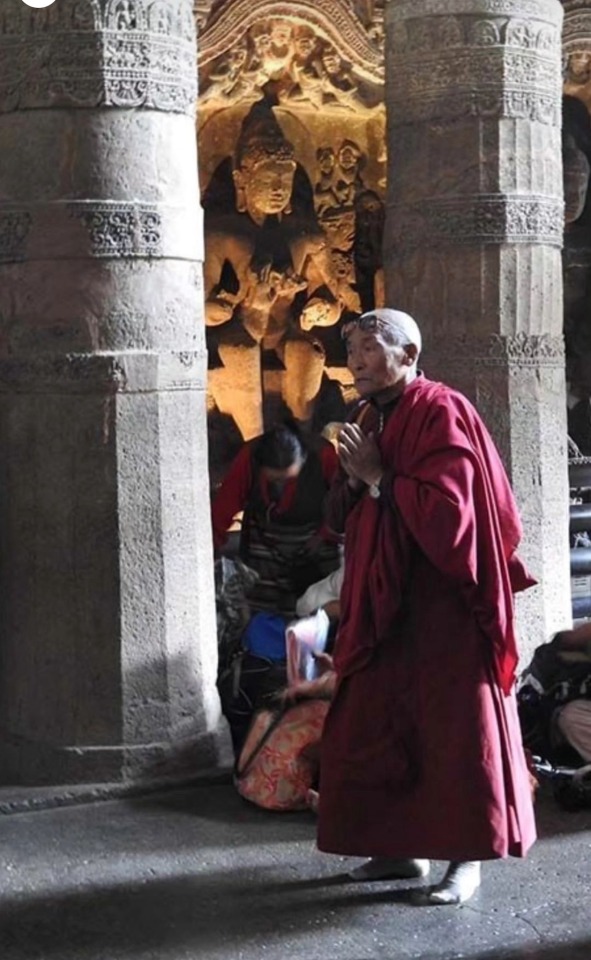
Shunyata
Shunyata, often translated as "emptiness," is a fundamental concept in Buddhist philosophy and practice. It's a key component of the teachings found in Mahayana Buddhism, especially in the Prajnaparamita Sutras and the philosophy of the Madhyamaka school, developed by Nagarjuna. Shunyata is a profound and nuanced concept that challenges our conventional understanding of reality and offers a path to liberation from suffering.
1. **The Nature of Shunyata:**
Shunyata suggests that all phenomena lack inherent or independent existence. This means that nothing exists in isolation or as a self-contained entity. Instead, everything is interdependent and interconnected. This perspective counters our ordinary perception of a solid, unchanging reality and challenges the notion of a fixed and enduring self (anatman).
2. **Dependent Origination:**
Shunyata is closely related to the concept of dependent origination (pratityasamutpada). According to this teaching, all things arise in dependence on multiple causes and conditions. Nothing exists in isolation; everything is a result of an intricate web of interrelationships. Shunyata deepens our understanding of dependent origination by emphasizing the absence of inherent essence in these interrelated phenomena.
3. **The Middle Way:**
Nagarjuna, a prominent philosopher in the Madhyamaka tradition, articulated the concept of the "Middle Way." This Middle Way asserts that we should avoid the extremes of eternalism (believing in inherent existence) and nihilism (denying existence altogether). Shunyata is the path between these extremes, recognizing the conventional reality of phenomena while acknowledging their ultimate emptiness.
4. **Liberation and Wisdom:**
Shunyata is not just a philosophical idea; it serves as a practical guide for spiritual development. In Buddhism, the ultimate goal is liberation from suffering (nirvana). This liberation is achieved through wisdom (prajna), which arises from a deep understanding of shunyata. When one realizes that all things lack inherent existence, attachment, aversion, and ignorance—the root causes of suffering—begin to dissolve.
5. **Compassion and Emptiness:**
An essential aspect of Mahayana Buddhism is the union of wisdom and compassion. The realization of shunyata leads to an understanding of the interconnectedness of all beings. This understanding fuels compassion (karuna), as one sees that the suffering of others is intimately linked to one's own. Compassion motivates Buddhists to work for the benefit of all sentient beings.
6. **Meditative Practice:**
Meditation plays a crucial role in understanding and experiencing shunyata. Through deep contemplation and mindfulness, practitioners aim to penetrate the illusion of inherent existence. They strive to see the emptiness of their own thoughts, emotions, and even the self. This meditative insight is a transformative experience on the path to enlightenment.
In conclusion, shunyata is a profound and central concept in Mahayana Buddhism, challenging our conventional understanding of reality and leading to a deeper insight into the nature of existence. It encourages practitioners to see beyond the surface of things and recognize the interdependence and emptiness that underlie all phenomena. Ultimately, the realization of shunyata is considered a path to liberation from suffering and the awakening of wisdom and compassion for the benefit of all sentient beings.
1 note
·
View note
Text
i remember first reading about affect theory via sara ahmed, and loving it loving it loving it, because of how it weighs the unknowability of the innumerable conditions of our phenomenological makeup, but then halfway thru im like wait this is just pratityasamutpada -_-
3 notes
·
View notes
Photo

Uf, qué año. El año de la Rata de Metal tiene mucho espíritu Skaven.
Entonces, la interdependencia. Pratityasamutpada. La enseñanza más importante del Buda, con la cuál se liberó. ¿Algo abstracta? No creo: une persone come una sopa de murciélago en Wuhan y el mundo se para.
¿Qué es la interdependencia?
La interdependencia es, esencialmente, la comprensión de que nada existe por si mismo. Es decir, nosotres, cada une de nosotres, existimos por una red de causas y condiciones. Nuestros padres, obviamente, pero múltiples otres persones: les doctores, les maestres, etc.
Pero la interdependencia es algo más complejo. ¿Qué es cada une? Pensemos primero ¿qué es lo que somos? O aún más ¿quiénes somos? Podemos pensar que sabemos quién somos (oh, dulce niñe del verano…) pero ¿sabemos como el otre es? ¿O tenemos una imagen, simplemente? ¿Y qué somos salvo una imagen, hacia el otro y hacia nosotres?
Si mañana nos liberamos, nos levantamos convertidos en Arhats y morimos antes de poder hablar con nadie…¿realmente fuimos Arhats? ¿Cómo saberlo?
Une podría decir: bueno, yo lo sabría…ok, pero esa imagen de nosotres que queda en el resto ¿no tiene relación con nosotres?
Si tiene relación ¿nos hemos liberado realmente?
Si no tiene relación ¿podemos estar seguro de que les otres existen?
Es más, dado que nosotres tenemos simplemente una imagen propia ¿estamos segures de que existimos?
Esta forma, como una ilusión pero no ilusoria de existir, interdependiente, esto es la interdependencia. Es esencialmente una cadena que une a seres que, a primer análisis parecen separades, en otro análisis no lo son y finalmente existen de una forma no articulable. Es esta cadena que permite que una persona termine afectando el mundo. Pero ¿empezó todo en esa persona? ¿Y si esa persona hubiera tenido más dinero y hubiera elegido comer mejor? ¿No sería el mundo diferente?
Porque lo que nos enseña la interdependencia es que para liberarnos todes les seres tienen que ser liberades. Para poder alcanzar mí Budeidad, necesito que todes puedan llegar a ella. Si quiero realmente no ser pobre en mi vida, debo intentar que nadie lo sea; esa es la verdadera riqueza.
En un momento en que les millonaries americanes que adoran al mercado han hecho de esta adoración un culto de la muerte (literal, en el caso de varios de elles), en el que se muestra que dejar a les seres más pobres de lado no solo es moralmente equivocado sino que es totalmente erróneo hasta de un punto de vista productivo, en el que hay gente que ofrece la vida por ayudar en hospitales y miles de ayudas online mientras otres solo piensan en como aprovechar la pandemia para “ganar” quizás sea el momento para pensar en dónde nos paramos.
¿Creémos que existimos individualmente y nos podemos liberar individualmente? ¿O podemos ver en esta pandemia a la interdependencia?
1 note
·
View note
Text
What is “Spiritual Practice” Anyway?
From a Buddhist perspective, spiritual practice is anything that calls us into communion with this very moment, and (importantly) in doing so, illumines the precise nature of it.
What is that precise nature? It is defined by impermanence (anicca), insubstantiality (anatta), and a tendency toward dissatisfaction (dukkha) when mind isn’t paid to those first two factors. When stewarded appropriately though, the final factor is supplanted with the defining factor of interconnectedness (pratityasamutpada) which transmutes suffering into wonder.
~Sunyananda
#zen#buddhism#buddha#buddhist#dharma#enlightenment#sangha#nirvana#awakening#peace#spirituality#spiritual#practice
5 notes
·
View notes